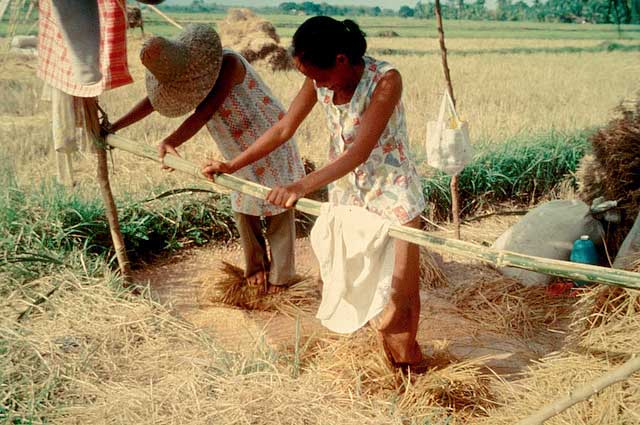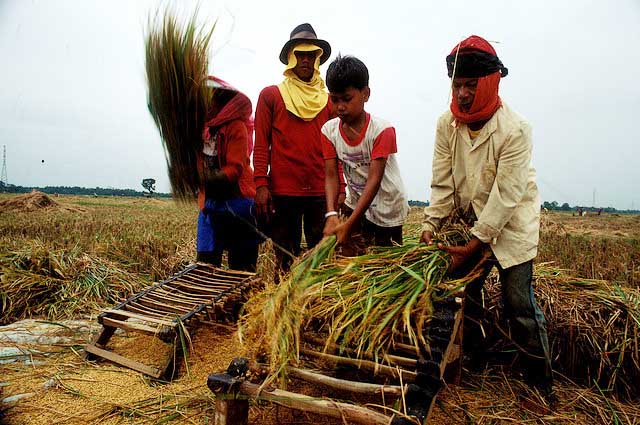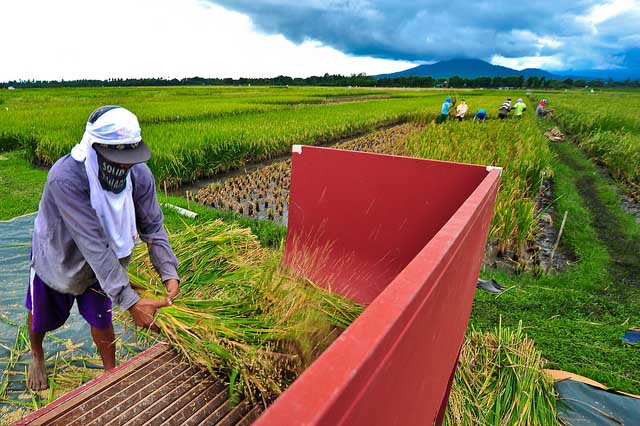Threshing
Threshing is the process of separating the grain from the straw. It can be either done by hand, by using a treadle thresher or mechanized.
Manual threshing
The common method for manual threshing is hand beating against an object, treading, or by holding the crop against a rotating drum with spikes or rasp bars.
Hand beating methods are normally used for threshing rice that easily shatters (i.e., at lower moisture content).
Methods of manual threshing
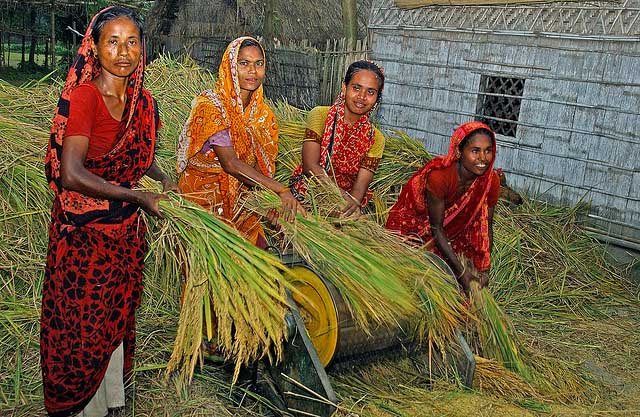 Pedal thresher (recommended best practice)
Pedal thresher (recommended best practice)
The pedal or treadle thresher consists of threshing drum, base, transmission unit and a foot crank. When pedaled, the threshing drum rotates and rice can be threshed when panicles are applied against the threshing drum. Because small straws, chaff, and foreign matter drop along with the threshed grain, whole grains must be separated using a flail, sieve or by winnowing (see section on cleaning).
Trampling
This involves the use of bare feet or animals to thresh the crop. The crop is spread over a mat or canvass and workers trample with their own feet or use their animals. Animal treading or trampling is normally carried out at a designated location near the field or in the village. In some regions, animals have been replaced by tractors. After animal treading, the straw is separated from the grains and cleaning of the grain is done by winnowing, with or without the aid of an electric fan. Losses are high from broken and damaged grains.
Threshing rack
The crop is held by the sheaves and beats it against a slatted bamboo, wooden platform, or any other hard object such as a steel oil drum. This is very labor intensive.
Flail
The use of a flail or stick for threshing the crop is not popular for rice.
Machine threshing
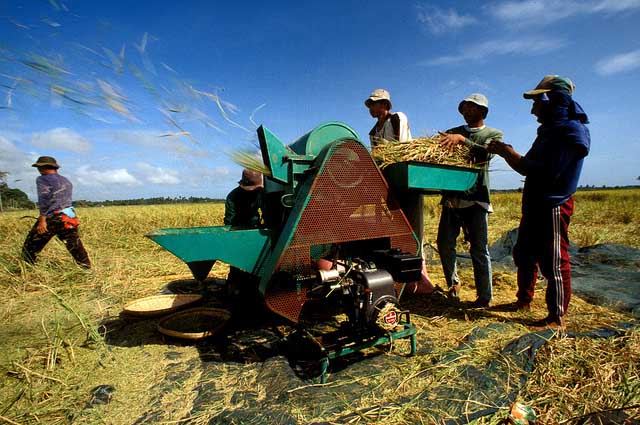 The use of small stationary machine threshers commonly replaces manual threshing given the high labor requirements of manual threshing. Stationary threshing is generally done in the field, or near the field.
The use of small stationary machine threshers commonly replaces manual threshing given the high labor requirements of manual threshing. Stationary threshing is generally done in the field, or near the field.
Many stationary threshers for paddy have peg-toothed threshing drums, however threshers fitted with wire-loop or rasp-bars are used as well. Most threshers are of the feed-in type (e.g. entire crop is fed through the thresher) which ensure high throughput.
Hold-on threshers (only panicle is fed into the machine) generally have a lower capacity than feed-in threshers and are primarily used in areas where rice straw is bundled and stored for later use.
Large stationary threshers are fitted with additional cleaning devices such as an oscillating screen, centrifugal blower, and windboard, and threshed grain can be handled without further cleaning.
In many regions, machine threshers are owned by individuals who offer custom operations to farmers. This requires that farmers schedule harvesting dates depending on the availability of the thresher. Many threshers are mounted on trailers or trucks which enables the operator to quickly move from field to field.
Principle of feed-in type axial-flow thresher
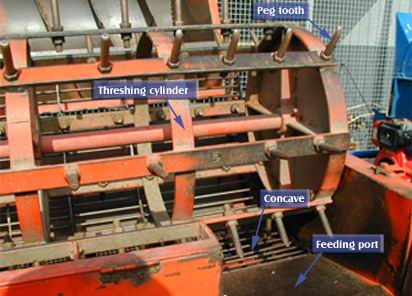 Harvested crop is loaded onto the tray and fed into the opening between the cylinder and the concave at one end of the machine. The pegs on the threshing cylinder hit the material separating the grain from the straw, and at the same time accelerating them around the cylinder.
Harvested crop is loaded onto the tray and fed into the opening between the cylinder and the concave at one end of the machine. The pegs on the threshing cylinder hit the material separating the grain from the straw, and at the same time accelerating them around the cylinder.
The majority of the grain is threshed during initial impact but further threshing is performed as the material moves axially until the straw is discharged at the opposite end. Threshed grain, including impurities such as leaves and short pieces of straw, pass through the openings in the concave and fall on the oscillating screen where large impurities are separated.
Guidelines on proper threshing
- For hand threshed crops, partial drying in the field for a couple of days may be necessary to lower the moisture content and make threshing easier.
- The highest milling yield will be attained for hand threshed, sun dried rice at grain moisture content between 18–20%.
- Care must be taken not to overdry the crop if it is to be transported any distance before threshing as excessive shattering will occur.
- While the crop may be dried before threshing, dried crop should not be subjected to rewetting. Rewetting causes grain fissures which lead to high broken grain when milled.
For machine threshing
- Harvest the grain at optimum maturity to maximize yield and minimize losses. Axial-flow threshers that are particularly designed for rice can handle very wet crop.
- Timing of threshing
Ideally, machine threshing should begin immediately after cutting and often these crops can be threshed in the field.
Immediate threshing reduces the exposure of crop to insects, birds and rodents, disease, and molds. Crop that is piled over a period of time generates heat that will serve as an ideal medium for growth of molds, disease and pests. Piling for several days will lead to grain discoloration, germinated grains, and spoilage. - Machine adjustments
Always make sure that threshing drum speed and the cleaner settings are done properly according to the crop conditions. Wrongly adjusted threshers create higher threshing loss and grain damage.
